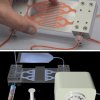Sepsis, a dangerous inflammatory response to an infection, is notoriously difficult to control (30-50% mortality rate). The problem is that antibiotic therapies are becoming less effective as microorganisms evolve and become antibiotic-resistant and often, before you’re able to figure out which antibiotics will work, the pathogens have already taken over with terrible consequences. Researchers have developed a spleen inspired device, an earlier version of which we reported on back in 2008, to filter blood of these pathogens to prevent patients from developing sepsis and going into septic shock.
In order to target the pathogens, which includes bacteria, viruses, fungi, protozoa, as well as different toxins, the researchers genetically engineered a native protein, mannose-binding lectin (MBL), to create an opsonin that could be used without complications. Some of their modifications included deleting parts of the protein that would promote blood coagulation and parts that allowed it to bind to macrophages. The final product, an Fc-containing MBL (Fc stands for Fragment, cystallizable region) has basically the same properties as the wild-type MBL, and it was shown to be able to bind to antibiotic-resistant microorganisms such as methicillin-resistant S. aureus, Staphylococcus epidermidis, Klebsiella pneumoniae and E. coli.
Once the Fc-MBL was coated with magnetic nanoparticles and mixed with blood, it bound to the various pathogens. To finally remove these pathogens from the blood, researchers created a device that mimics the spleen’s venous sinusoids. The device contains two fluidic channels with rectangular slits between them. The first fluidic channel runs a saline solution, while the other passes the blood sample through. To remove the pathogens, a magnet on the biospleen pulls on the nanobeads, and with them the Fc-MBL and whatever pathogen they’re attached to.
The researchers tested this device to see whether or not the MBL could bind to not only the bacteria and microorganisms, but also the toxins the bacteria create that is the main cause of sepsis. They tested the efficiency with LPS Endotoxins, which proved to be successful. Furthermore, they filtered human blood full of bacteria and fungi at 1 liter an hour and the results showed that the device removed most of the pathogens in 5 hours.
source:Sepsis, a dangerous inflammatory response to an infection, is notoriously difficult to control (30-50% mortality rate). The problem is that antibiotic therapies are becoming less effective as microorganisms evolve and become antibiotic-resistant and often, before you’re able to figure out which antibiotics will work, the pathogens have already taken over with terrible consequences. Researchers have developed a spleen inspired device, an earlier version of which we reported on back in 2008, to filter blood of these pathogens to prevent patients from developing sepsis and going into septic shock.
In order to target the pathogens, which includes bacteria, viruses, fungi, protozoa, as well as different toxins, the researchers genetically engineered a native protein, mannose-binding lectin (MBL), to create an opsonin that could be used without complications. Some of their modifications included deleting parts of the protein that would promote blood coagulation and parts that allowed it to bind to macrophages. The final product, an Fc-containing MBL (Fc stands for Fragment, cystallizable region) has basically the same properties as the wild-type MBL, and it was shown to be able to bind to antibiotic-resistant microorganisms such as methicillin-resistant S. aureus, Staphylococcus epidermidis, Klebsiella pneumoniae and E. coli.
Once the Fc-MBL was coated with magnetic nanoparticles and mixed with blood, it bound to the various pathogens. To finally remove these pathogens from the blood, researchers created a device that mimics the spleen’s venous sinusoids. The device contains two fluidic channels with rectangular slits between them. The first fluidic channel runs a saline solution, while the other passes the blood sample through. To remove the pathogens, a magnet on the biospleen pulls on the nanobeads, and with them the Fc-MBL and whatever pathogen they’re attached to.
The researchers tested this device to see whether or not the MBL could bind to not only the bacteria and microorganisms, but also the toxins the bacteria create that is the main cause of sepsis. They tested the efficiency with LPS Endotoxins, which proved to be successful. Furthermore, they filtered human blood full of bacteria and fungi at 1 liter an hour and the results showed that the device removed most of the pathogens in 5 hours.
source:MIT Technology
Artificial Biospleen Cleans Blood With Magnets

